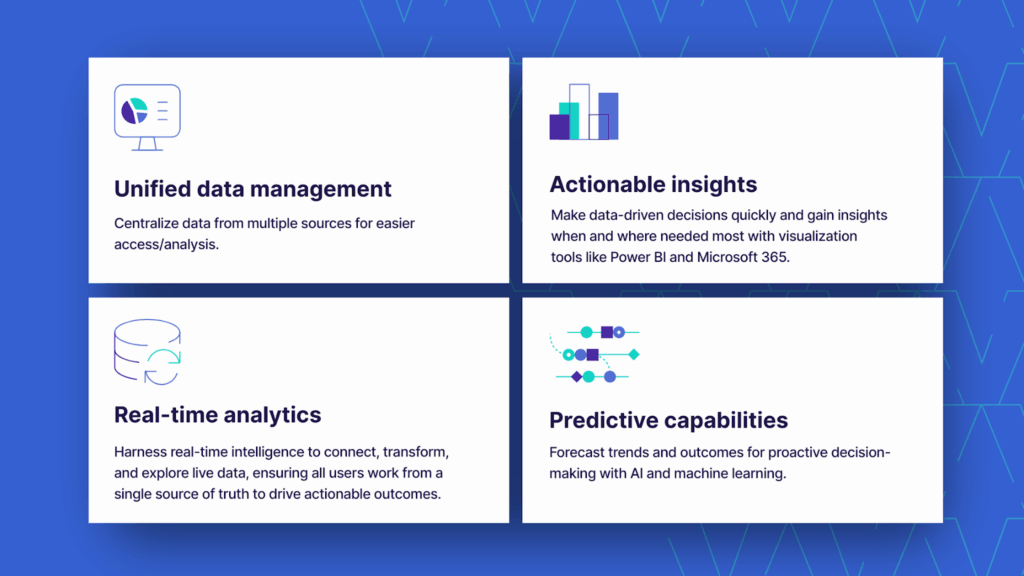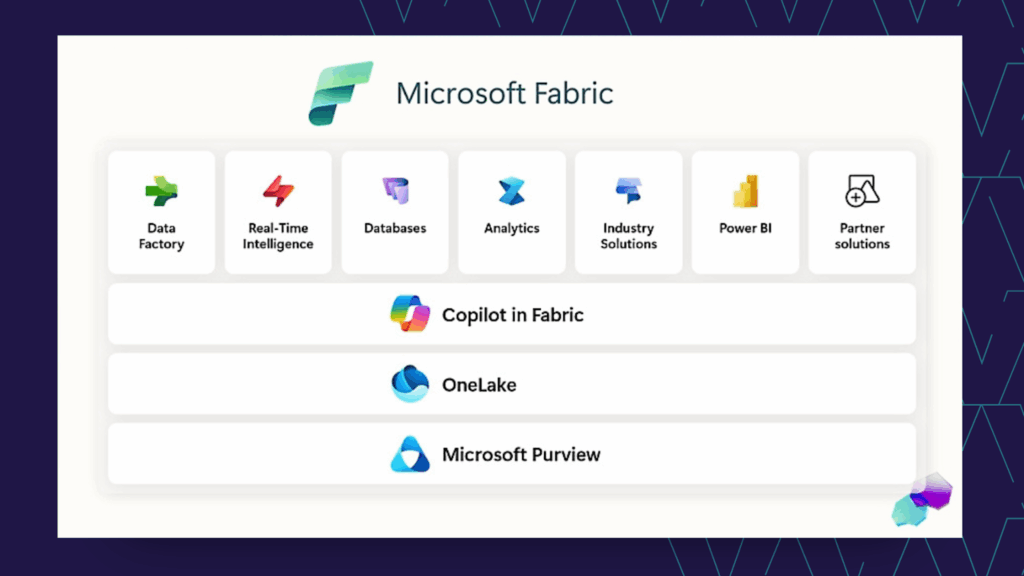Home / Blog / Insights / From Legacy BI to Microsoft Fabric: How to Migrate with Confidence

•
From Legacy BI to Microsoft Fabric: How to Migrate with Confidence
The way organizations use data is changing. Business intelligence used to be about retroactive reporting, but today it can empower you to explore, predict, and act on insights in real time. This new wave of AI, automation, and self-service analytics are raising the bar for what’s possible, and for many teams, that’s created both excitement and pressure to modernize.
Yet behind every innovative dashboard or predictive model lies one truth: none of it works without a strong data foundation. And when that foundation is spread across aging on-premise systems and disconnected tools, analytics becomes harder, slower, and less reliable.
This is where Microsoft Fabric comes in. Fabric brings together every stage of the data journey—from ingestion to visualization—within one unified cloud platform. For organizations still relying on legacy BI tools, moving to Fabric represents not just a technical upgrade but an opportunity to create a single, scalable analytics environment that’s built for the future.
In this post, we’ll explore:
- Why Legacy BI Tools Hold Businesses Back
- What Microsoft Fabric Is and What Makes It Different
- What to Consider Before Migrating to Fabric
- Common Pain Points (and How to Overcome Them)
- A Practical Migration Framework
Why Legacy BI Tools Hold Businesses Back
Many analytics environments still run on tools built for another era, when data lived safely inside a company’s four walls and reporting cycles were measured in weeks, not minutes. Those systems did their job for years, but as cloud adoption accelerates, they’re starting to show their limits.
Legacy BI platforms such as SSRS, Tableau Server, or custom on-premise dashboards were never designed to connect easily with modern, cloud-based ecosystems. The result is an analytics stack that feels fragmented and high-maintenance (more like a patchwork than a platform). Here’s what that can look like today.
Disconnected systems and siloed data
Departments often run their own versions of truth. Marketing might have a Tableau instance, Finance relies on Excel exports, and Operations keeps data locked in a local SQL Server. Without seamless integration, leaders spend more time reconciling numbers than interpreting them.
High cost of maintenance
On-premise BI requires constant upkeep: hardware, licensing, backups, and manual updates. IT teams get weighed down maintaining infrastructure instead of delivering value through insights. Even small changes, like adding a new data source, can require days of re-engineering.
Slow, manual reporting cycles
Legacy workflows depend on human intervention at every step—exporting CSVs, refreshing datasets, distributing reports. By the time dashboards reach decision-makers, the data is already out of date.
Limited scalability and flexibility
As organizations adopt more SaaS tools or expand globally, on-prem systems struggle to keep up. Scaling storage or compute capacity isn’t as simple as flipping a switch. It often means buying new servers or re-architecting environments entirely.
Security and governance gaps
Older BI setups lack unified governance. Permissions, version control, and audit trails are handled in multiple places, creating risk and complexity. That fragmentation makes it difficult to maintain compliance and visibility in a data-driven world.
When it comes to modernization, the time is now. As Carlie Idoine, VP Analyst at Gartner, explained:
Nearly everything today – from the way we work to how we make decisions – is directly or indirectly influenced by AI.
But it doesn’t deliver value on its own – AI needs to be tightly aligned with data, analytics and governance to enable intelligent, adaptive decisions and actions across the organization.
Even the smartest AI tools depend on the strength of the data foundation, and that’s where many legacy BI environments fall short.
Gartner predicts that by 2027, half of all business decisions will be augmented or automated by AI agents. By 2029, 10 percent of global boards will use AI guidance to challenge executive decisions that are material to their business. Without a unified, cloud-based analytics platform, most organizations won’t be ready for that future.
That’s where Microsoft Fabric comes in, bringing together the full analytics lifecycle in one secure, scalable ecosystem designed for the age of intelligent, data-driven decision-making.
What Is Microsoft Fabric? What Makes It Different?
Microsoft Fabric is an end-to-end analytics platform that unifies everything from data movement and storage to modeling, visualization, and governance. It brings together tools that once lived in separate environments—Power BI, Azure Data Factory, Synapse, and more—under one simplified experience.
As Patricia Harty, Analytics Consultant at Convverge, explains:
Fabric is a cloud platform that combines all of the data solutions within one umbrella in Microsoft. It does everything from data engineering, to data science, and your standard business intelligence and analytics.
Fabric’s design eliminates the friction that often exists between IT and business users. Instead of stitching together multiple tools or maintaining fragile integrations, teams can now collaborate within a single ecosystem that keeps data consistent, secure, and ready for analysis.
To dive deeper into the fundamentals, visit our earlier post: What Is Microsoft Fabric?
Key Benefits of Microsoft Fabric
1. OneLake: A single source of truth
Fabric’s OneLake serves as a unified data foundation, consolidating information from multiple sources into one governed environment. It simplifies access and eliminates the duplication issues that often plague legacy BI systems.
2. Seamless integration with Microsoft tools
Fabric is built to integrate with the Microsoft ecosystem, including Power BI, Azure Synapse, and Excel. This means organizations can modernize without fully abandoning their existing workflows.
3. Built-in security and compliance
With Microsoft’s governance framework and role-based access controls, Fabric provides a secure environment that aligns with enterprise-grade compliance requirements.
4. AI-ready architecture
Fabric’s architecture is designed for the next generation of analytics, allowing organizations to layer in machine learning, Copilot, and other AI capabilities as they mature.
5. Simplified experience for all users
From data engineers to business analysts, Fabric offers a consistent interface and shared workspace. That accessibility helps drive adoption and makes advanced analytics attainable across the organization.
Ultimately, Fabric isn’t just another BI tool, because it operates like the connective tissue for your organization’s entire data strategy. It unifies people, processes, and platforms around a single vision: a modern, intelligent analytics foundation that can evolve with the business.

What to Consider Before You Migrate to Fabric
Migrating from legacy BI tools to Microsoft Fabric isn’t just about moving data from one platform to another, or as we like to call it, a “lift and shift.” It’s about modernizing how your organization thinks about, manages, and uses data.
A successful migration starts with understanding what you have, what you need, and what you want the end state to look like. Before beginning the process, pause to consider the following:
1. What data and reports are truly business-critical?
Not every report or dataset needs to make the move. Focus on what drives value today and what will continue to serve future business goals. A clear inventory helps reduce clutter and prioritize the data that matters most.
2. How will governance, access, and permissions evolve?
A cloud environment like Fabric introduces new opportunities for transparency and control, but it also requires a plan for user roles and data access. Define who owns what, and ensure policies align with your organization’s compliance and security standards.
3. What integrations and dependencies exist?
Legacy BI environments are often woven tightly into other systems. Mapping out integrations early helps avoid disruption when workloads shift to Fabric. Consider whether data pipelines, automations, or downstream applications need reconfiguration.
4. What’s the desired experience for users?
A migration isn’t just a technical shift, because it changes how people interact with the data. Engage business users early to understand what they need most from the new platform, whether that’s faster access to insights, easier collaboration, or self-service analytics.
5. How is data being used today versus how it could be used tomorrow?
Think beyond current dashboards. Consider how Fabric can enable predictive analytics, machine learning, or AI-driven insights in the future. The goal isn’t to rebuild what exists, but to evolve it into something more agile and impactful.
Ultimately, every successful migration starts with alignment. When IT leaders, business stakeholders, and analytics teams share a common vision, the move to Fabric becomes not just a technology upgrade but a strategic move for your future.

Common Pain Points During BI Migrations (and How to Overcome Them)
Even with a clear roadmap, BI migrations can be complex. Legacy systems often have years of custom logic, overlapping data models, and deeply ingrained user habits. Knowing where the common stumbling blocks lie can help you plan ahead and avoid disruption.
Pain Point 1: Data mapping and quality issues
When moving data from multiple systems into a single platform, inconsistencies will inevitably surface. Old reports might rely on outdated definitions or manual workarounds.
Solution: Start with a data audit. Cleanse, validate, and document your data sources before migration to ensure accuracy and alignment once they’re in Fabric. This step saves significant time later when models and dashboards are rebuilt.
Pain Point 2: User adoption resistance
Change can be met with hesitation, especially from teams comfortable with familiar tools. Without buy-in, new systems risk going unused.
Solution: Engage users early. Show them what Fabric can do that their old tools couldn’t. From our experience, it’s easier to gain traction when migrations are approached in phases rather than all at once. By identifying and delivering quick wins early, users can see immediate value. This helps build confidence, excitement, and momentum long before the full migration is complete.
Pain Point 3: Governance complexity
As organizations modernize, they often discover that governance policies weren’t built to scale with cloud analytics. Managing permissions and compliance can quickly become overwhelming.
Solution: Leverage Fabric’s unified governance model. With built-in security, data lineage tracking, and centralized administration, you can grant oversight without giving up control.
Pain Point 4: Too many moving parts
A migration touches data pipelines, reports, storage, permissions, and integrations. Without structure, it’s easy to lose track of dependencies or stall progress.
Solution: Partner with experienced consultants who can sequence the work effectively. At Convverge, we help organizations identify which workloads to move first, where to pilot Fabric capabilities, and how to scale securely over time.
Every organization’s migration looks different, but the goal is the same: to move from fragmented analytics to a connected, insight-ready environment. With the right preparation and guidance, those pain points become opportunities to streamline, modernize, and future-proof how data is managed and used.
A Practical Migration Framework
Every organization’s data environment is unique, but successful migrations tend to follow a similar pattern. At Convverge, we help clients move from legacy BI systems to Microsoft Fabric through a structured, phased approach that minimizes risk and accelerates value.
1. Assessment and Strategy
The first step is understanding where you are today. We begin with an audit of existing BI tools, data models, and user workflows to identify what’s working and what isn’t. From there, we define goals, success criteria, and the right migration roadmap to get there.
2. Design and Pilot
Instead of migrating everything at once, we start small—focusing on a high-value use case where impact can be measured quickly. This pilot phase is where teams begin to see Fabric in action, learning how it changes their reporting, collaboration, and access to insights.
3. Migration and Optimization
Once the pilot proves its value, we move workloads incrementally. Data pipelines, models, and reports are rebuilt within Fabric using modern design principles to ensure consistency, accuracy, and performance. Each wave of migration is tested, validated, and optimized before scaling.
4. Training and Enablement
A platform is only as effective as the people using it. That’s why enablement is embedded into every phase of our process. We offer tailored training sessions to help technical teams manage Fabric effectively and business users feel confident exploring insights on their own.
5. Governance and Continuous Improvement
Post-migration, we establish governance frameworks that maintain control, ensure compliance, and support scalability. From there, organizations can continue optimizing and layering in advanced capabilities such as AI, Copilot, and machine learning.
With the right structure and support, a Fabric migration can transform analytics from a dreaded time drain into a true strategic advantage.
Why Partner with Convverge for Fabric Migrations
Partnering with the right team can ensure your Microsoft Fabric migration happens efficiently, strategically, and with measurable impact. We’ve done many of these, and here’s what our clients say about us:
- Microsoft expertise. As a certified Microsoft Solutions Partner, we’ve guided clients through every stage of analytics modernization—from legacy BI migrations to full cloud implementations that integrate seamlessly with Power BI, Azure, and Microsoft 365.
- Strategic approach. We don’t start with the tools. We start with your business goals. Our team develops a tailored roadmap that aligns technology decisions with outcomes that matter most.
- People-first mindset. Successful transformation requires buy-in. We help create early momentum with quick wins, hands-on training, and champions who keep adoption strong across teams.
- Ongoing partnership. Our work doesn’t end at go-live. We continue supporting governance, optimization, and the rollout of emerging Fabric and AI capabilities so your environment evolves with your business.
With Convverge, migration becomes a managed, measurable process.
Turning Data Frustration into Fabric Empowerment
For many organizations, legacy BI systems have become a source of frustration because they’re complex, costly, and slow to deliver the insights leaders need. But a move to Microsoft Fabric is a chance to redefine how your business engages with data altogether.
If your current BI environment feels like it’s holding you back, now’s the time to look ahead.
Explore what a Microsoft Fabric migration could look like for your team >


